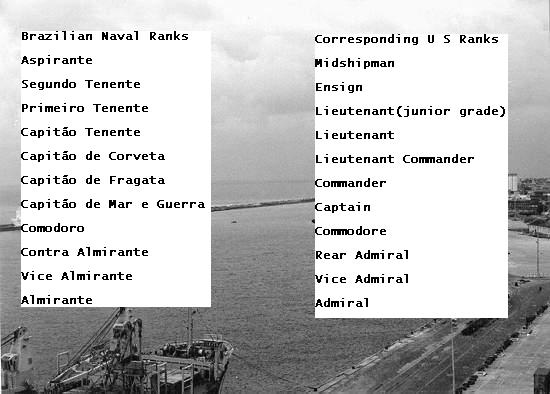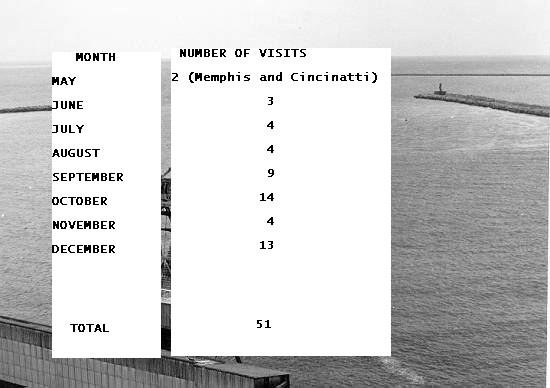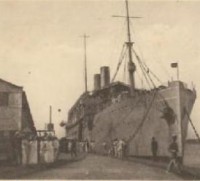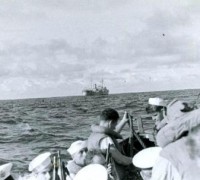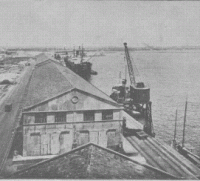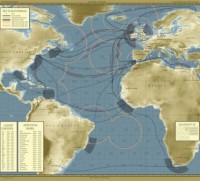- COMMANDER SOUTH ATLANTIC
5)THE NEUTRALITY PATROL
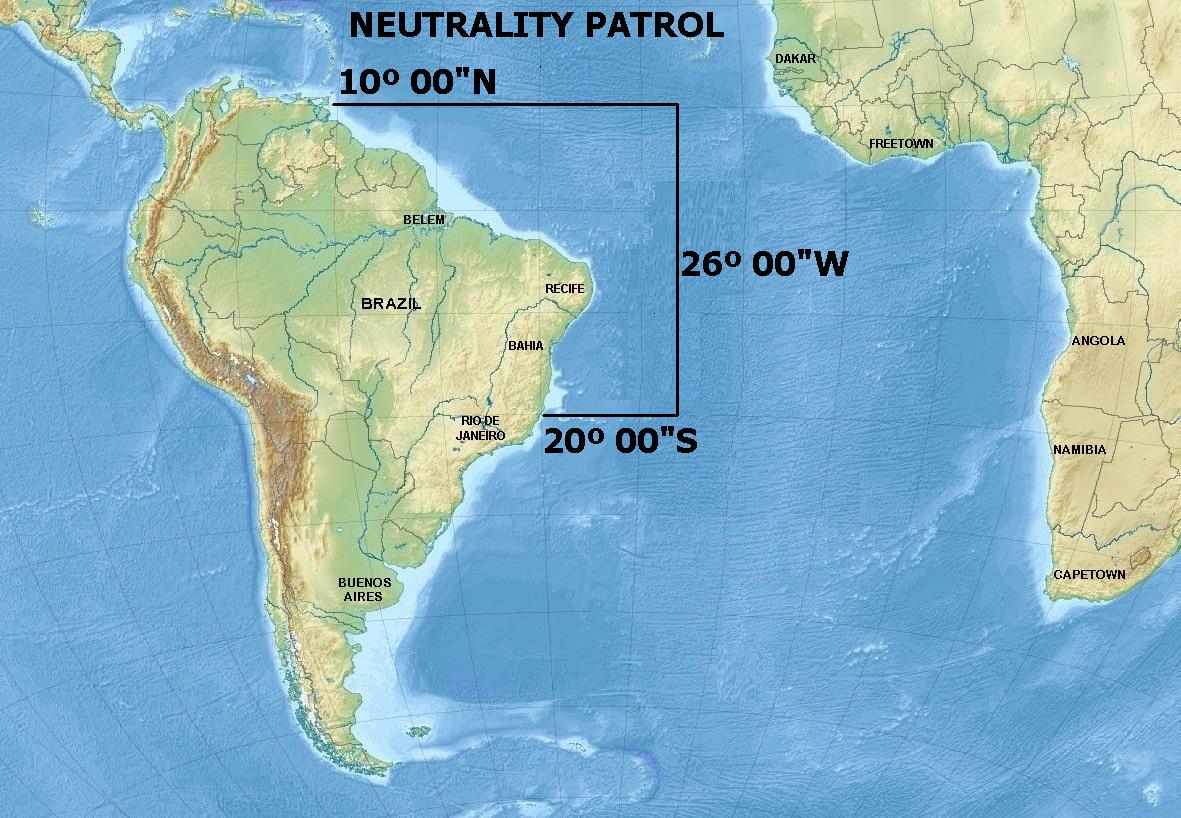
At Port of Spain the Memphis and Cincinnati made rendezvous with other units of Cruiser Division Two. The Admiral now divided the ships at his disposal into task groups One and Two. The first consisted of the Cruiser Memphis and Cincinnati and the destroyers Davis and Warrington. Group II contained the Milwaukee and Omaha Cruisers and the Sommers and Jouett destroyers.
The Omaha, Davis and Warrington were not yet present. The former being temporarily unfit for work , because of a failure of her propulsive plant that kept her in the Navy yard. The ships on hand left port of Spain on May 30. Group II consisting of the Milwaukee Sommer and Jouett proceeded on patrol.
Group I, still comprising the original Memphis and Cincinnati, went to San Juan P. R. by way of St. Lucia, purposely avoiding close contact with Vichy held Martinique. They reached their destination on May 23, having traveled 7093 miles since leaving Newport 28 days earlier. Task Group II, in charge of Captain Mc Glasson, patrolled in conformity with Operation Order number 2-41. It first sailed from Port of Spain to a point designated as point X-Ray. located at Lat 10ºN and Lon 26ºW, falling between the Cape Verdes and Ascension Island.
It then proceeded to Point Baker, a little east of São Paulo Rocks on the Equator. On June 1, the three ships of Task Group II, the Milwaukee, Jouett and Sommers, entered Recife. Since the Admiral did not accompany the group, this visit was not as important as the one in May. Two days were spent in Recife, after which the ships returned to Port of Spain for refueling. Sailing again, they made point X-Ray once more, but this time proceeded to Point Affirm, a trifle south of the Cape Verde Islands. The completion of their patrol took them westward to San Juan.
To avoid repetition which would involve a great deal of sameness, the ships continued to patrol in very much this manner until the time of Pearl Harbor. The Admiral, sailing in the Memphis, visited Recife again on July 3, and once more on August 15. The July stay lasted five days; the August visit only two. Local Recife newspapers had begun to attach importance to those frequent calls and often made them the subject of feature stories.
For instance, the Diario de Pernambuco, the city’s most widely read journal, in its Sunday edition, of September 7, 1941, carried a headline to the effect that two units of the Neutrality Patrol, the Cruiser Milwaukee and the Destroyer Warrington, would arrive that day. The ships had both been before, but for some reason had not previously attracted so much attention.
The Diario announced that they would refuel and get supplies. It also carried descriptions of the ships and said that they would stay for 24 hours, though as a matter of fact they remained three days. Soon after departing they were back for a brief stop. This time, the paper notes, the officers of the Milwaukee gave a cocktail party at the Grande Hotel, the number one of the city, for their captain, who had just been promoted to Admiral and was being transferred to a new assignment.
Still later in this same notice appeared the statement that Admiral Ingram and other officers of the North American ships had been at the International Club and later entertained at the Country Club. The Diario gave its first headline to Admiral Ingram on October 14, when it announced the presence in Recife of the “Chief of the American Squadron in the South Atlantic”. The Admiral came as usual aboard the Memphis, which had entered the port two days before.
Senhor Novais Filho, the Mayor of Recife, was offering a luncheon to the distinguished visitor at the Escola Superior de Agricultura at Dois Irmaos. This was in return for the luncheon which the Admiral had earlier given to Senhores Magalhaes and Novais Filho and General Mascarenhas. After the luncheon, the industrialist, Felino de Miranda, was to give a cocktail party for the Admiral. Among those attending would be the Interventor, the General, the General’s Chief of Staff, the U S Naval Observer, the Brazilian Secretary of Agriculture, the Port Captain, the American Consul and other dignitaries.
The importance of these rounds of social events cannot be overlooked.They formed an essential preliminary to future cooperation and created an atmosphere of good will and mutual trust. Meanwhile, the Admiral did everything in his power to cultivate the key men of the district, beginning with the Interventor.
Agamenon Magalhaes had acquired a reputation as being a hard man to deal with, but, since he was the key to the situation, this obstacle had to be tackled. Following the official luncheon on board the Memphis, the Admiral arranged an appointment with the Interventor, where, as he says “all the cards were put on the table, face up.” It was explained to the Brazilian Official exactly why the Force was in the South Atlantic.
The Americans admittedly came through the sufferance of the Brazilian Government, but they could be a business asset as well as a political help if the situation were rightly handled. The Interventor might rest assured that the Admiral desired to cultivate friendly relations in every way. However, the Americans expected fair treatment and normal cooperation from Brazil.
The Admiral stated that he expected to lean heavily on the Interventor for support and would deal with other Brazilians directly through him, the Commanding General of the Area, and the Naval Captain of the Port. Senhor Magalhaes responded to this in a very satisfactory manner. Since the first big matter that had to be taken up was the foodstuffs the American Navy would buy, and their cost, the Interventor sent for his Secretary of Agriculture and gave him some important instructions.
The Secretary could issue orders permitting the American Force to enjoy the wholesale Cooperative Association prices. Under no circumstances would there be any deviation from this practice. This marked the breaking of the ice. Not only was the Interventor extremely friendly thereafter, but he became in time strongly pro American. With regards to Great Britain, however, his feelings of antagonism remained the same.
Even so, the time was not at hand for basing the ships on Recife, as there were still too many things lacking there. Plans in the meantime were made as fast as possible, not only for improving port facilities but for increasing the shore establishment as well. Pernambuco State is Agricultural, which made Brazilian fresh fruits and green vegetables procurable in ample quantities. Armour and Company of Brazil would furnish fresh meats.
The oil available was in very limited amounts, so limited in fact that ships often had to wait idly for some time before obtaining it. However, Recife had capacity for storing sufficient oil for the present needs of ships and so had Bahia. At that time no shore repair facilities existed in either place. At Bahia, despite the fine natural harbor and excellent docks, conditions left even more to be desired than at Recife. The population of the city is about 350,000. On the good side of the situation were the uncontested facts that Bahia possesses character, is well policed and clean. It is more picturesquely situated than is Recife, and makes an excellent liberty port, being popular with the sailors.
The authorities encountered were of high caliber and disposed to be friendly. The Federal Interventor of the State of Bahia, Dr. Landulfo Alves, had the reputation of being somewhat pro-Axis, partly because of his German wife. He was, however, very conscientious, and seemed disposed, in personal relations at least, to be friendly. Coronel Renato Pinto Aleixo, whom the Admiral described as one of the finest soldiers in Brazil, was distinctly pro-American. Capitao de Fragata Luiz Bezerra Cavalcanti, who was Captain of the Port, likewise proved a valuable friend.
In accuracy it should be observed here that “Bahia”as applied to the city, is a popular misnomer. The real name of the place is São Salvador, and the state surrounding it is rightly Bahia. But in every day language “São Salvador” is seldom heard, the state name having prevailed over the city’s correct appellation. Much the same thing has been true of Recife, which, until a few years ago, was known generally as Pernambuco, at least to foreigners.
Table of Naval Ranks in both Brazilian and US Navy.
Yet the advantages of a first class officialdom did not rule out the unfavorable location and the equally important scarcity of supplies. An example is the case of fuel. At Bahia the rate of delivery was very slow, it requiring twice the time to fuel a ship there that was needed at Recife.During 1941, progress was made in developing facilities in Brazil.
Lieutenant Commander Hodgman, from time to time, was assigned specific work at points along the coast other than Recife. At Bahia and at Maceio, in the state of Alagoas just below Pernambuco, he laid the groundwork and obtained information necessary for the establishment, in the future, of Naval and Air Bases. Before the end of the year other Naval Observers arrived in Brazil.
To Bahia came Lieutenant, later Lieutenant Commander and Commander, M. B. Saben , USN, Retired. The Diario de Pernambuco reports his arrival in Recife by air on September 30. The following day he reached Bahia and assumed the Naval Observer’s duties which eventually were to be expanded to the command of the second largest facility in Brazil. Natal’s first naval Observer was Lieut. Comdr. H.C. Frazer, USN, Retired, who arrived 14 October 1941. Lieut. Comdr. Edward Breed came to Belem, at the mouth of the Amazon, on 17 November 1941, to become naval Observer there.
However, since Recife was designed to be ultimately the center of U.S. Naval Activity in the south Atlantic it was there that matters were pushed fastest. In August, Lieut. Comdr. Hodgman’s first assistant arrived, second Lieutenant D. J. Kendall of the Marine Corps Reserve. This help was rendered necessary by the increasing number of visits by ships of the Admiral’s Force. Spaced over the entire year, the statistics show the following, leaving out the lone visit of the Vincennes in March.
Visits of US ships at Recife. The ships using the port during that period of time were the Memphis, Cincinatti, Milwaukee, and Omaha, Cruisers; the Jouett, Sommers Warrington, Davis , Clemson, and Greene, Destroyers; the Laramie, Kaweah, and Patoka, Auxiliary Oilers; the Acadia; U.S. Army transport ; and the Thrush, Auxiliary Seaplane Tender.
The patrols until the month of November, were as a rule rather monotonous. This was a period of training for personnel of the ships. Fairly frequent gunnery practices took place, including surprise practices using flares for the Anti Aircraft Batteries and “dummy” periscope targets for broadside guns.
Trade routes were constantly observed and important changes were immediately reported. The Force received orders to board any suspicious merchant ships, especially if their replies to signals were unsatisfactory. Unfortunately, it was discovered, ships flying American flag were among the worst offenders in answering identification at sea. “Incidents”, on the whole, were rare. The Memphis on September 23, sighted a periscope in Lat. 10º 20’N, Log. 54º 50’W. Accompanying destroyers dropped four depth charges, but no effect could be perceived.
When the British steamer I. C. White was torpedoed September 27, at 10º 26’ N, 27º 30’ W, a search was made for the submarine by Task Group 3.6, but nothing was found. On October 24, the Auxiliary Oiler Patoka, reported a suspicious vessel in Lat. 06º 44’S, Lon. 34º 26’W. Task Group 3.6 again made an unsuccessful search.
Five days later Task Group 3.5, made a submarine sound contact in 15º 45’N, 30º 00W, dropping three depth charges. Further search revealed nothing, so it was concluded that the sub had received no damage. About the same time the Milwaukee sighted a self propelled tank lighter with landing ramp apparently in good condition, in Lat. 14º 00’N, 26º 26’W. No further report was heard on this.
HyperWar - Commander South Atlantic Force. U.S. Naval Administration in WW II
